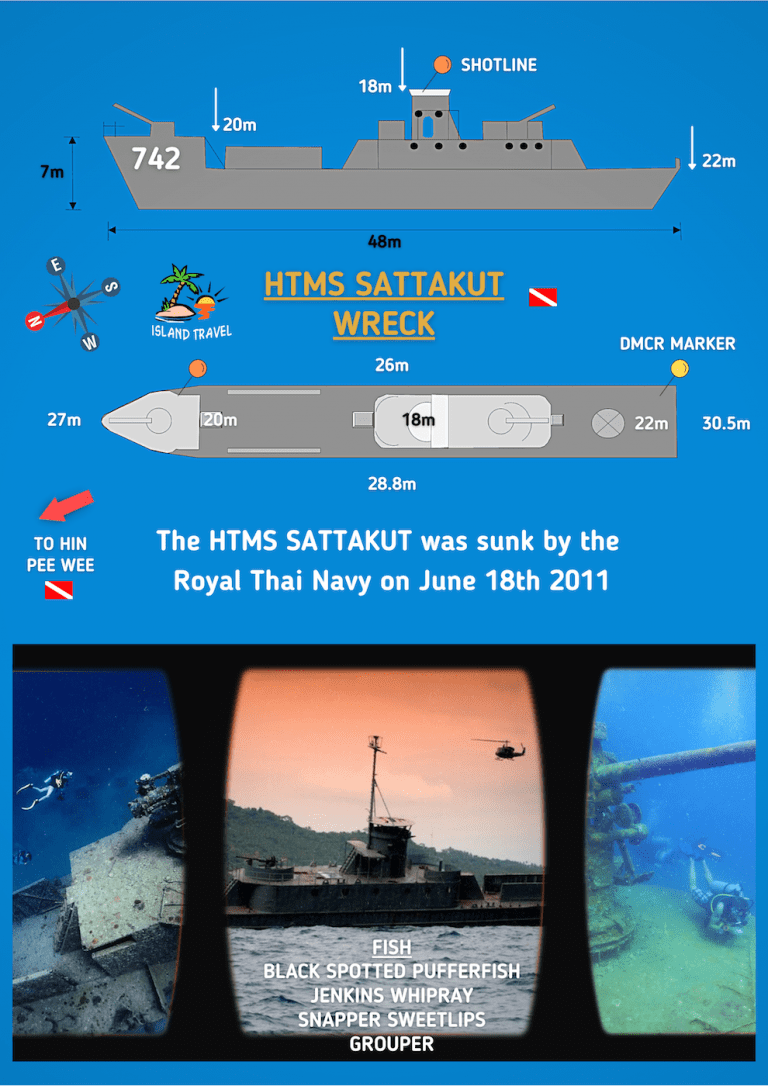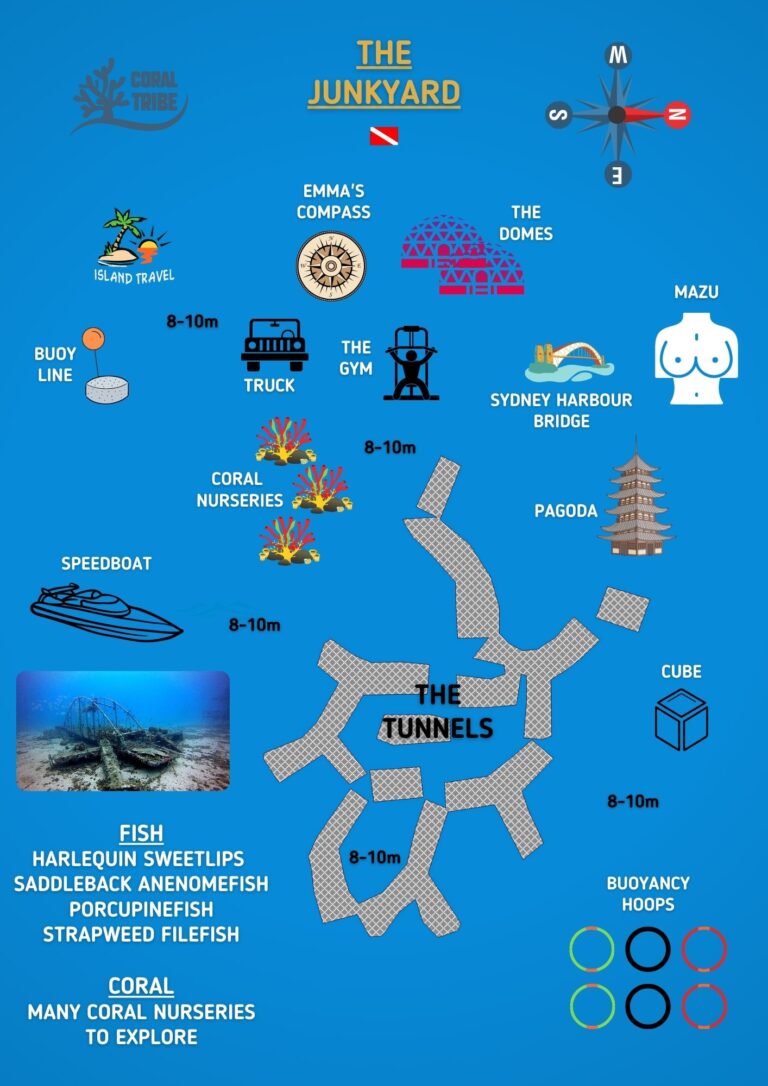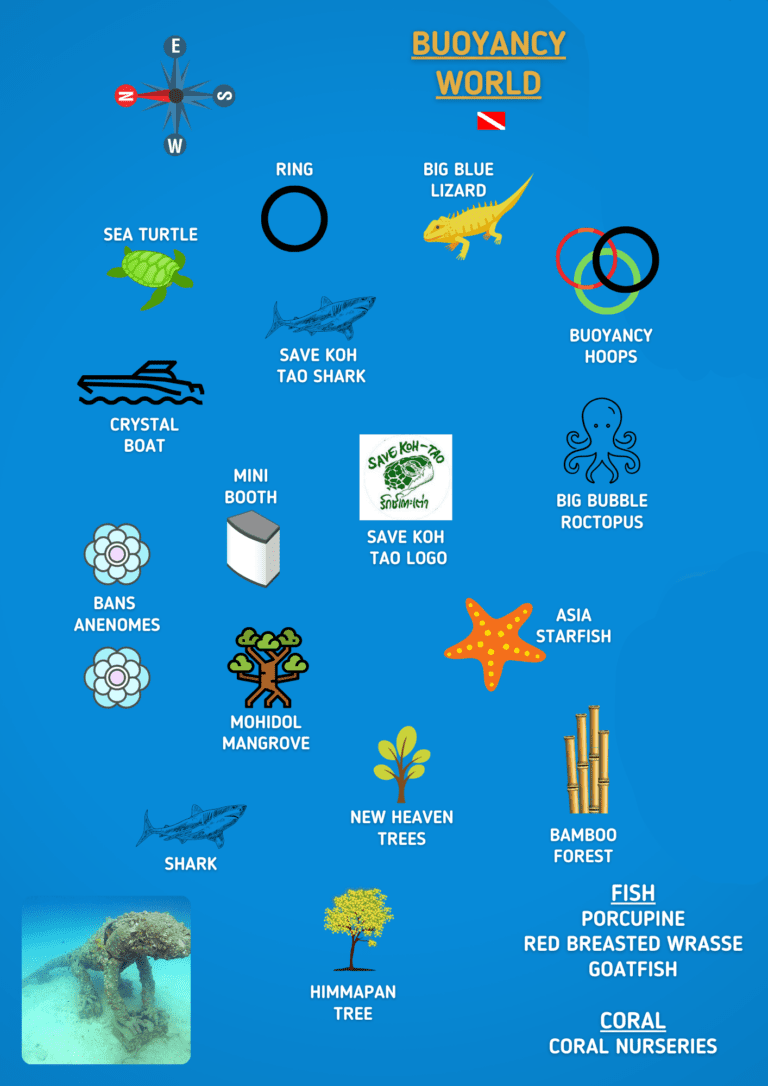Artificial Diving Sites
Famous Koh Tao Dive Sites
Koh Tao is well known for its vibrant tropical reefscapes and for the volume and diversity of marine life that accompanies them. There is more to Koh Tao dive sites than just coral reefs though, as there are a few dedicated artificial dive sites around the island too. Wreck dives are a prime example, providing both exciting dive opportunities and interesting stories from the past, while at the same time alleviating dive traffic from some of the busier sites, thus allowing corals and marine life a chance to rejuvenate. With this in mind, a few other artificial dive sites have been designed and built by various conservation teams, with the sole purpose of providing alternative yet still invigorating dives, and something completely different from day to day reef diving.

HTMS Sattakut
As the premier wreck dive on Koh Tao, it is often used for Advanced Diver training and Specialty Diving courses. Located south of Hin Pee Wee and just a 10-minute boat ride away from Sairee Beach, it is a convenient and interesting wreck dive. The HTMS Sattakut was donated to Koh Tao by the Thai Navy and sunk purposefully for the diving community in June 2011. In its operational days, this battleship was originally used as a US Navy vessel during the Second World War and was stationed mainly in Okinawa, before being commissioned to the Royal Thai Navy. The HTMS Sattakut is just under 50 metres in length and sits in the water column between 18 and 30 metres, making it a suitable site for advanced divers only. Having been thoroughly prepared prior to sinking, the HTMS Sattakut is free of any hazardous materials and has fewer risks and entanglement hazards compared to wrecks that have done down due to natural causes. The HTMS Sattakut is a fantastic wreck to look around and has become home to many species of marine life like snapper, sweetlips, and groupers that use it for safety and protection. It’s large conning tower and cannon style guns at the front and rear are particular highlights, and if you have a torch you can peek into the portholes too. Please note, however, that unless you are a certified wreck specialty diver, going inside the wreck is not permitted.

Junkyard
Junkyard is a completely unique dive site that was created using recycled and upcycled junk materials and trash to make structures for divers to explore. Junkyard is located just a few hundred metres off the beach in Mae Haad Bay. Since its inception, Junkyard has continued to grow year on year, with additional structures being added to increase the size and diversity of the site. Stand out pieces of underwater art made out of various pieces of junk include a set of pyramids, a windmill, a car, a toilet sculpture, and a replica of the Sydney harbour bridge. What is so great about Junkyard is that all of the installations act as shelter and homes for marine life, while also providing structures that are suitable for transplanting and growing new corals. There is a whole host of fish at Junkyard that you will hardly see anywhere else on the island, including strapweed filefish, juvenile harlequin sweetlips, pipefish, boxfish, and saddleback anemonefish.

Buoyancy World
The creation of the Save Koh Tao group, one of the original conservation organisations on the island, Buoyancy World sits between Twins dive site and the coast of Koh Nang Yuan Island. It was designed specifically to remove some dive traffic from Twins, while also providing a fun area for divers to practise their buoyancy skills, and create some artificial homes for marine life in the process. Win, win, win! The smaller structures have successfully created coral nurseries for fish such as porcupine pufferfish, red-breasted wrasse and goatfish. With a range of structures including a giant octopus and an oversized starfish holding hoops, plus a whole host of training hoops, balance beams and other buoyancy aids, Buoyancy World certainly lives up to its name. As such, this dive site is often used on the buoyancy dive elective on Advanced Diver courses.
Other Wrecks
Aside from the HTMS Sattakut, there are a few other wrecks on Koh Tao, but none that are as safe and easy to explore:
- Catamaran wreck Tanote Bay: This tiny catamaran sits at around 18 metres, so is accessible to all levels of diver. It is located about a 5 minute swim out of the bay though, so it is easy to miss if your navigation is off and there is very little to see on the way there or back.
- MV Trident: The MV Trident lies on the sand at 36 metres close to Shark Island, so it is not suitable for any divers who do not have their deep and/or wreck specialty licenses. The strong currents in the area also make planning dives on the MV Trident more difficult.
- The Unicorn: This wreck is located a few hours travel from Koh Tao and sits in 50 metres of water. It is covered in fishing nets and only used by technical divers due to the level of experience and additional equipment required to dive it safely.
- The Torpedo: The Torpedo is a 70 metre long Japanese cargo ship that was used for carrying teak logs that resemble the shape of torpedos, hence its name. It sits in a sandy grave between 45-55 metres and is another example of a Koh Tao wreck that is used exclusively by the tech diving community.
Other Manmade Dive Sites
Aside from Junkyard and Buoyancy World, there are a few other artificial structures around Koh Tao to explore. Most are very small, however, and not necessarily deserving of an entire dive:
- Hin Fai (BioRock): Commonly referred to as BioRock, Hin Fai means ‘electric rock’ in Thai, and was the first proper artificial dive site structure to be developed on Koh Tao. The dive site comprises many domes onto which coral was transplanted before a low voltage current was run through the metal base structure to stimulate growth.
- Ocean Utopia: Located at Tao Tong, Ocean Utopia is an underwater art installation that also serves as an artificial reef. At about 12 metres deep, the structures comprise eerie bronze-casted human figures with long limbs.
- Concrete Block Projects: Several sets of large concrete blocks have been donated by the Department of Marine and Coastal Resources (DMCR) over recent years, and deployed at various sites such as Sail Rock, Aow Leuk, Aow Mao, and Mango Bay. The aim is to provide nurseries for marine life and corals, and to act as training aids for divers practising their buoyancy skills.